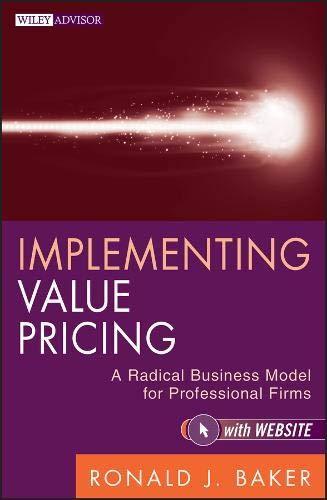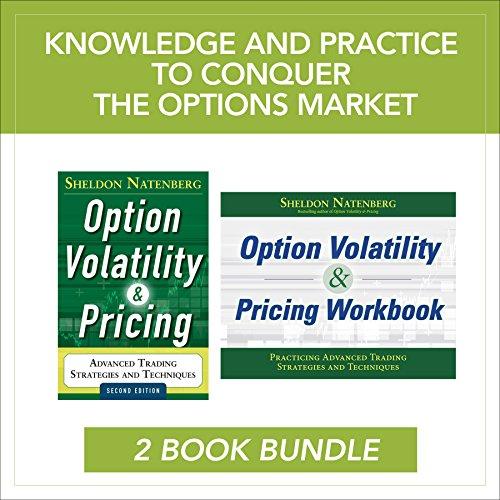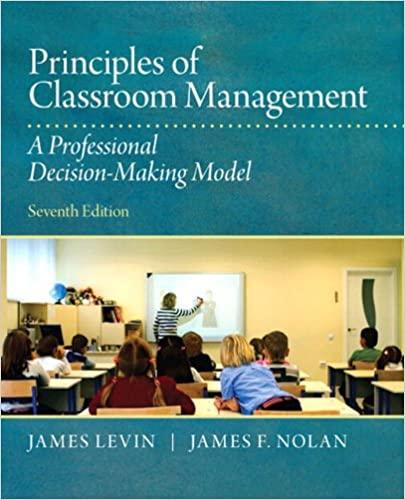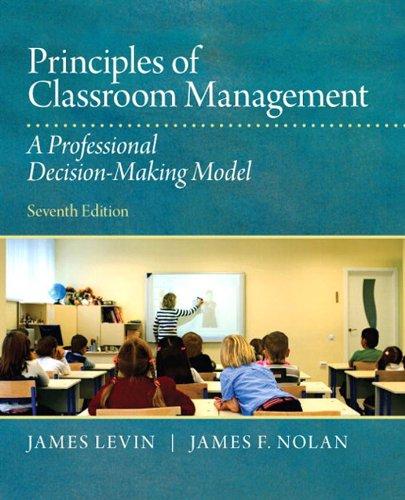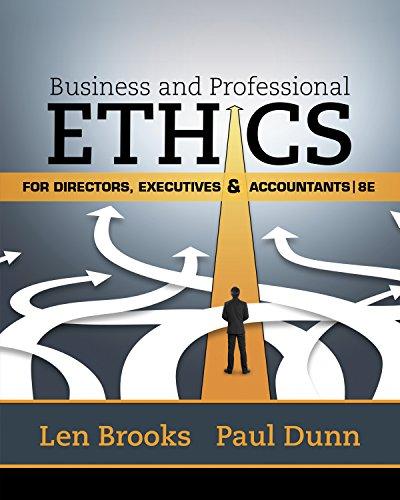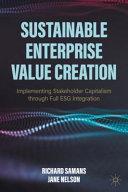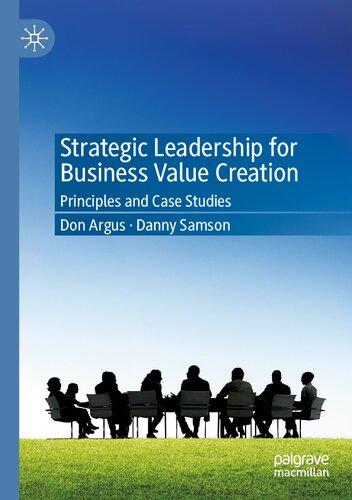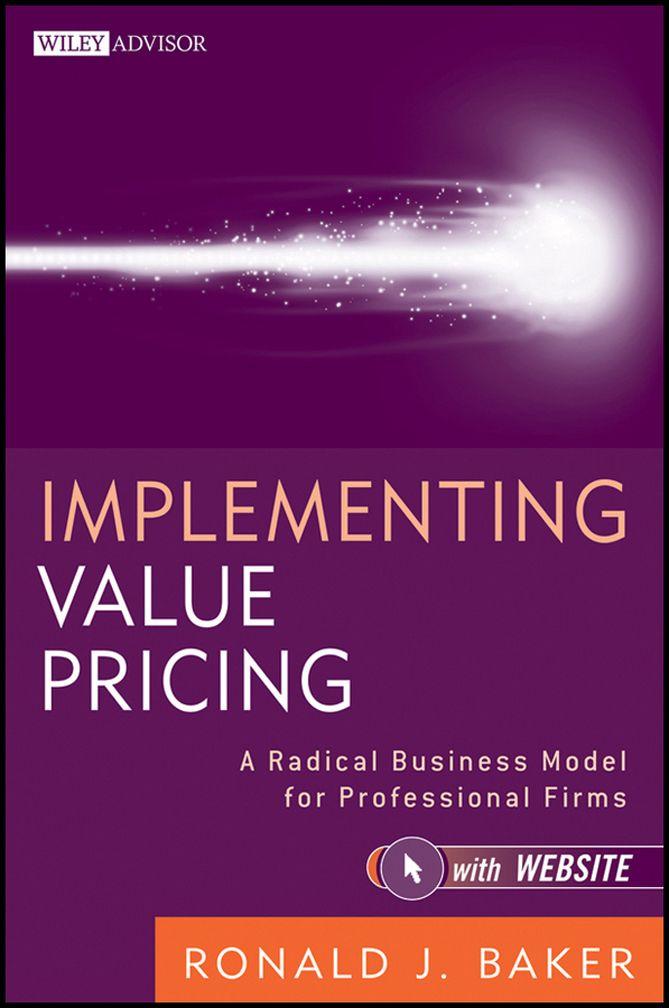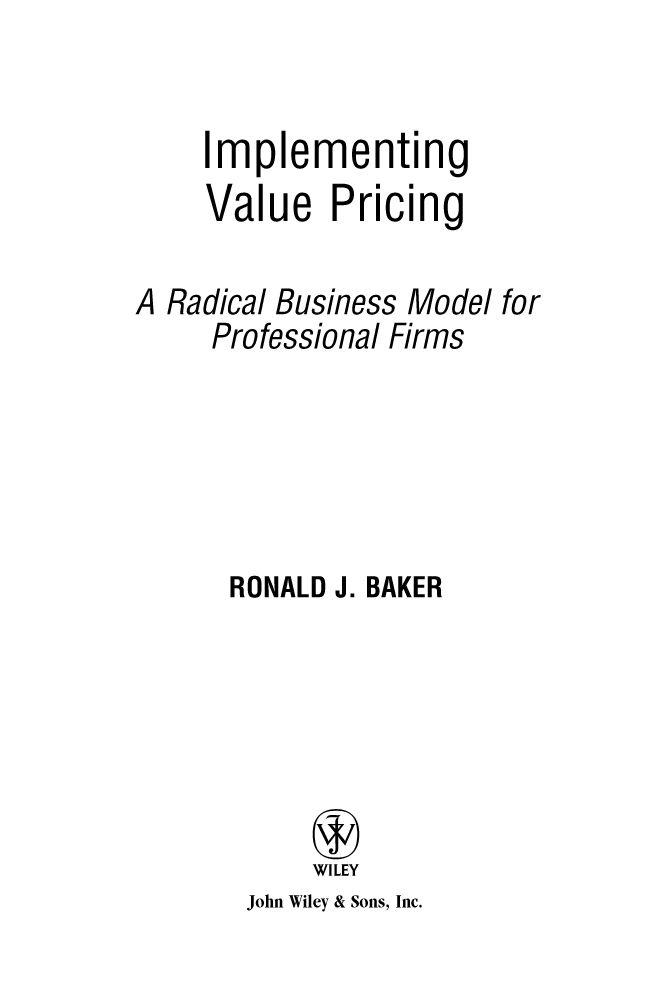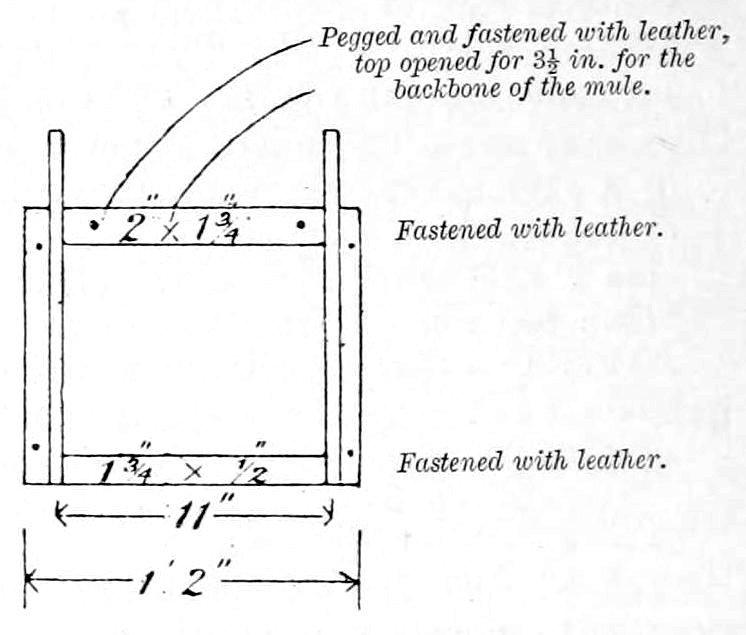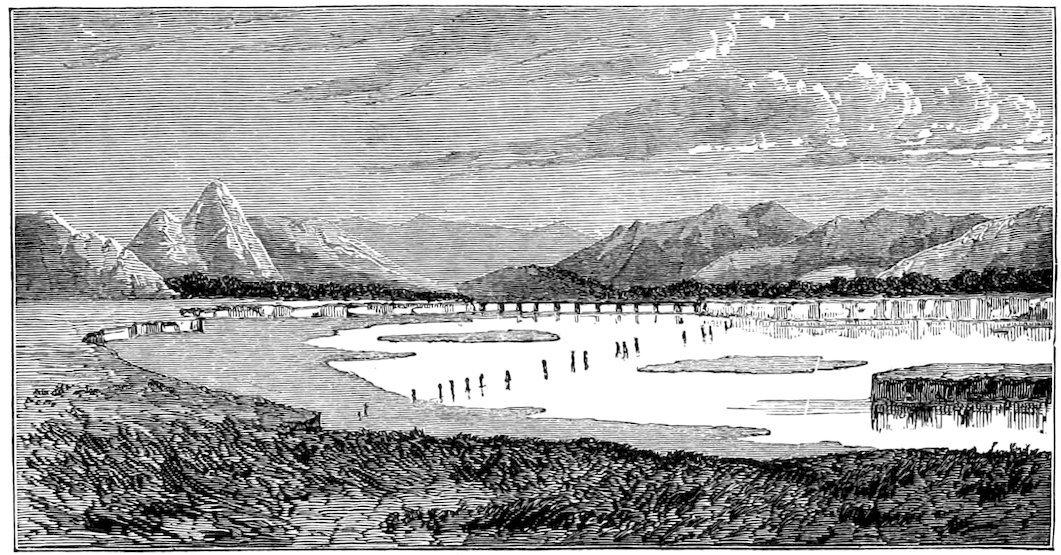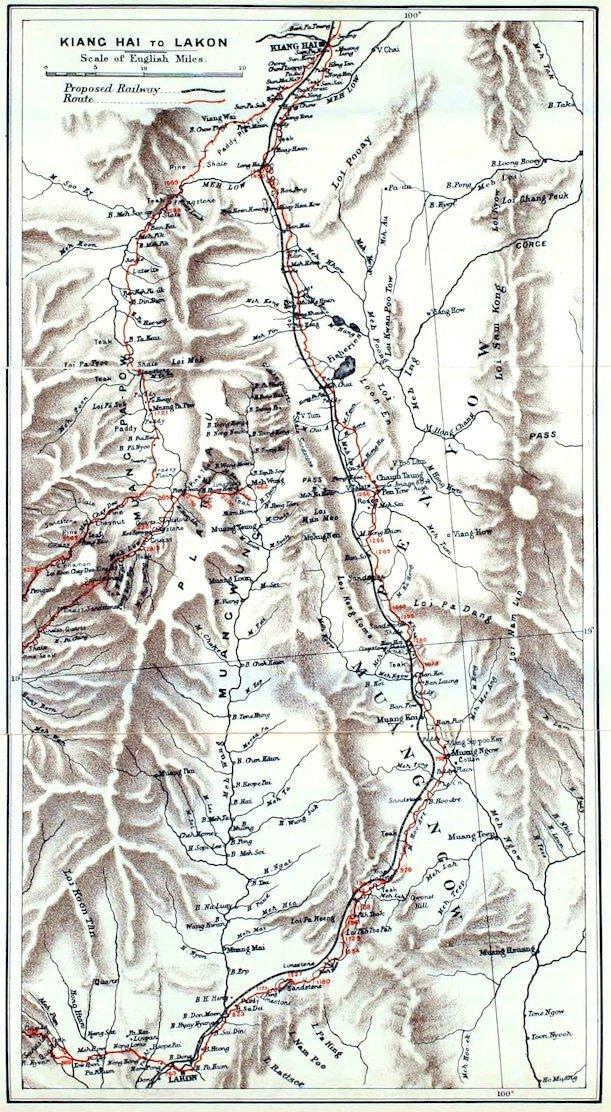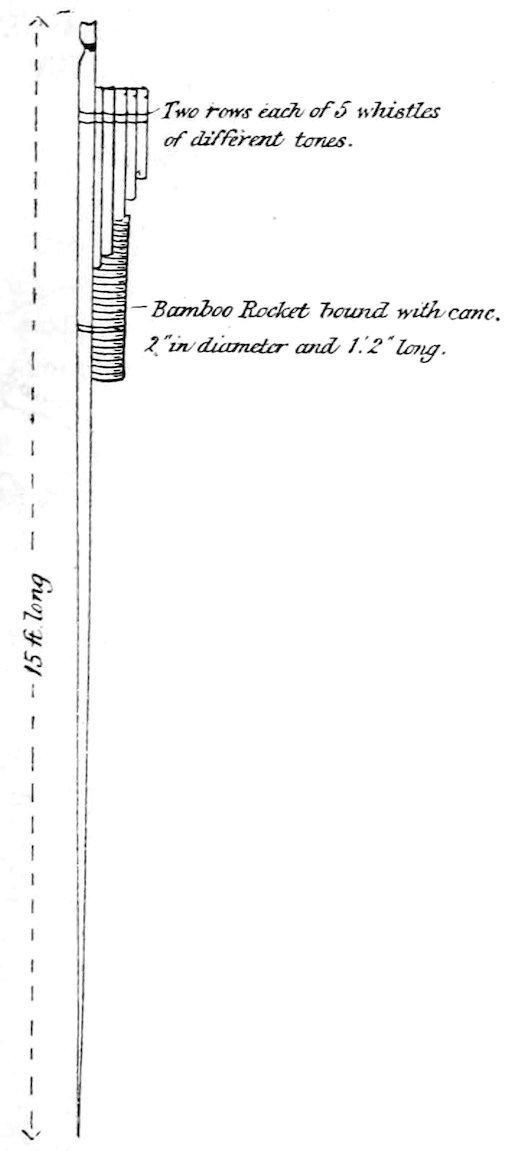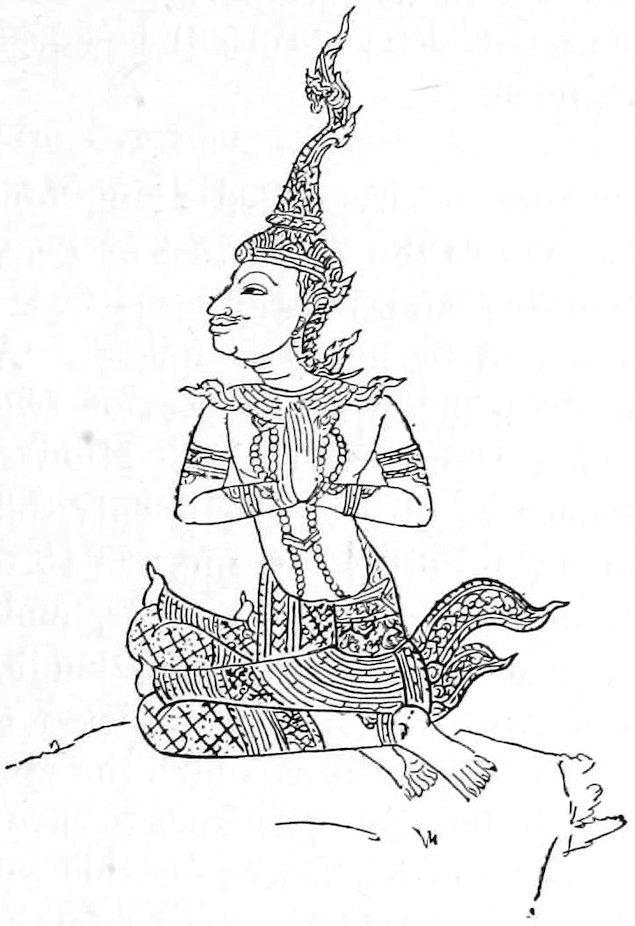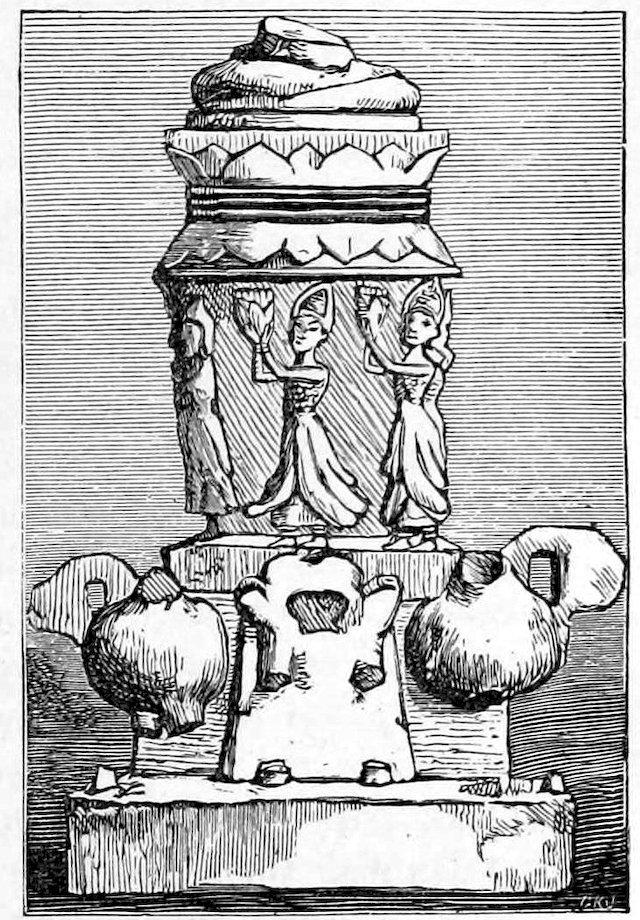Foreword
This book should come with a warning label: Reading this book may cause a Ron Baker Headache.
Now, before you put the book down, let me explain: I’m not talking about a headache in a bad, migraine-y kind of way. Think of it more like what you get when you have an ice cream on a hot day, or drink a milkshake too fast. When you read Ron Baker, and even more so when you talk with him about value pricing, you get a feeling that your head is going to explode because you suddenly have too many thoughts and ideas in it. In other words, it’s a good kind of headache. A Ron Baker Headache.
I run a Boston law firm called Shepherd Law Group (shepherdlawgroup.com), which helps companies make easier workplaces. When employers get into situations where they need a lawyer, they often feel like they’re losing control. My job as a lawyer is to help them get some of that control back. But the problem is that most of the time, dealing with lawyers makes the employers feel like they’re losing even more control. This is because lawyers never tell them how much it’s all going to cost, so the employers don’t know what they’re getting into.
The main cause of this problem is, of course, hourly billing. So when I founded my firm a dozen years ago, I started looking into how I could kill the billable hour and get rid of timesheets. I read everything I could find on the topic, which was of little use. There was no one I could consult to learn how to fix prices in an employment-litigation law firm.
And then I found Ron.
The first Ron Baker book I came across was TheFirmofthe Future,which he coauthored with Paul Dunn. And I promptly got my first Ron Baker Headache. In a good way. My head
Another random document with no related content on Scribd:
men; Zimmé, 1000; Pheh, 300; and Lapoon the whole of the dependants of the prince who had been appointed ruler of Kiang Hsen. Lakon absolutely refused to comply with this order, and it was only after he was charged with rebellion by the king that he consented to send between 500 and 600 men with their families to Kiang Hsen. Up to the time of my visit the people had been merely arriving in dribblets, and only 607 houses had been erected in the State, of which 139 were in the city. The Chow Hluang said many immigrants from Lakon, Zimmé, and Lapoon were then on their way to Kiang Hsen, as the King of Siam was determined that the full tally ordered by him should be completed. Many of these immigrants were met by me when returning to Kiang Hai. On the Burmese side of the frontier the Moné Shans, the Ngio, had erected 641 houses.
The Chow Hluang appeared to be very angry with the chief of Lapoon, his former suzerain, for preventing some of the 2500 serfs, who had offered to follow him as their liege lord, from leaving Lapoon. It is the custom among the Ping Shans for a serf to have the right of changing his allegiance from one lord to another if he wishes to do so, and this right has always acted as a great check to the growth of oppression. On the Chow Hluang being appointed to Kiang Hsen, 2500 serfs placed their names on his list, and offered to accompany him with their families and slaves.
The rainfall is not nearly as plentiful in Lapoon as it is in Kiang Hsen, and the plains of Kiang Hsen are renowned for their fruitfulness: thus the people would greatly improve their prospects by the change; besides which, there are always fewer Government monopolies in the frontier districts. Kiang Hsen, being made into a separate State, would not be dependent upon Lapoon. The Chow Hluang of the latter State was therefore naturally averse to losing a large body of his people, and had consequently obstructed the emigration by all the means in his power. The chief of Kiang Hsen, tired of remonstrating with the chief of Lapoon, had appealed to Zimmé and Bangkok to have him compelled to send his adherents to Kiang Hsen.
The chief of Kiang Hsen was an old acquaintance and friend of Dr M‘Gilvary, and seemed well pleased to see him. Nothing struck me more during my journeys than the high estimation in which the American missionaries were held by the chiefs. Not only were they
on a kindly and friendly footing with them, but by their bold strictures upon acts of injustice, and by exposing and expostulating against the wickedness and senselessness of certain of the reigning superstitions, they had become a beneficent power in the country.
During our stay the chief did all he could to make us comfortable; sent us the best fruit, fowls, and vegetables at his disposal, and allowed an ox to be killed for us, although there were at that time not more than sixty oxen amongst the settlers in the whole region. After the animal was slaughtered, cut up, and removed, its late companions, attracted by the scent, gathered round the spot in the most pathetic manner, sniffing at the ground, and time after time, when driven away, returning, and wandering uneasily about, as if aware that some ill fate had befallen their comrade.
The day before we left Kiang Hsen, I took a walk to the pagoda on Loi Saun-ka-tee, the hill to the north of the city, in order to sketch the hills to the west of the plain, and, as far as possible, fix their position. The air was clear, and I got a splendid view. Loi Htong, Loi Ya Tow, and Loi Ta, which I had previously sketched on entering the Kiang Hsen plain, now lay a little to the north of west, at a distance of about seventeen miles. Farther to the north, Loi Pa Hem loomed up in the distance, and seemed not to belong to the same system of hills: this hill was passed by M‘Leod when on his way to Kiang Tung in 1837. The great plain we were looking at, in which a few hillocks outcropped, extended to the foot of the mountains, but its northern and southern extensions were hidden by the low hills on which we were standing, and the hillocks which we had skirted on our way to the city.
View of hills west of Kiang Hsen Plain from pagoda on hill.
On calling to say good-bye, before leaving on March 24th, I asked the chief about the floods that occasionally happened in the plain to
the south of the Meh Khum. These, he said, were chiefly caused by the flood-waters of the Meh Kong backing up the water of the Meh Khum. When the Meh Kong was at its highest, the inundation sometimes rose two and a half feet over the bank, but the flood never extended north of the Meh Khum, nor farther inland than Loi Champa and Hong Seu-a Teng (the fishery where the tiger leapt); and even in this strip of plain there was a space between the Meh Chun and the Meh Khum, extending to Ban Kan Hta, which was never overflowed. The land near the mouth of the Meh Khoke, and for some distance up-stream, was also subject to inundation, the flow of the water in that river being impeded by waterweeds. Having finished my calls, and made presents to the chief and officials, and thanked them for their hospitality, we had the elephants loaded, and a little after one o’clock in the afternoon left the city.
The first night we halted at Pang Mau Pong, where we had stayed on our way to Kiang Hsen. I chose a different elephant for the return journey, much against the wish of the Chow Phya, who was accompanying us; it being considered infra dig. for a gentleman to ride any but a male beast. But I preferred ease to dignity; my former long-legged elephant having jolted me with its jerking pace, and the one I chose, although a female, moving with an exceptionally easy gait. The elephant-driver, on my noticing that its head was salmoncoloured speckled with darker spots, assured me that if it had been a male, it would have been honoured as a white elephant, and presented to the King of Siam. My eyes had become so inflamed with the constant glare from the white paths, and from peering at the small figures on the silver rim of the prismatic compass, that I was obliged to give up night-work as far as possible, and on my return to England I had to commence wearing spectacles.
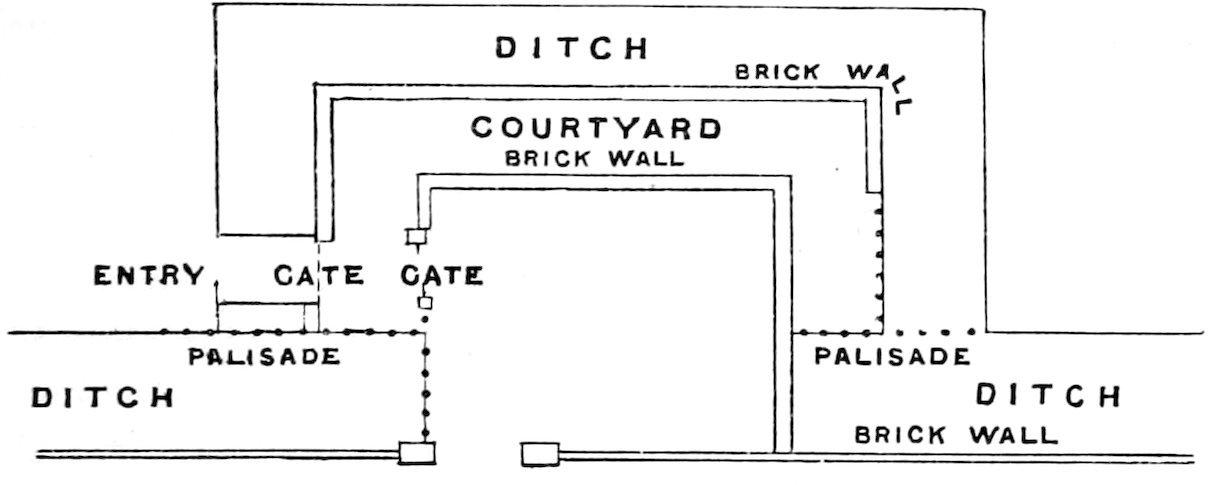
City enclosure. Sketch of an entrance to Kiang Hsen.
The next morning we started at 6 A.M., all feeling much better for our long halt at Kiang Hsen. The boys were quite rejuvenated, and walked along briskly under their umbrellas in the fresh morning air, singing scraps of songs as they went, joking with each other, and with all whom they met. When tired by a long journey they become jaded, and walk as if they have tar on their feet. After passing two caravans of laden cattle conveying the goods of some immigrants from Zimmé, we halted at a village to purchase fresh vegetables, but could only procure a few onions. Some of the trees had sprouted after the rain on the 21st, and everything was looking fresher than before.
Starting again, we passed some men carrying eel-spears, and stopped for breakfast at Kyoo Pow on the banks of the Meh Chun, where we bought some bringals and mustard-leaves. Many doves were cooing in the trees, and did not go into a pie, as I refused to let the boys have the gun to shoot them. We likewise saw a few green paroquets.
After breakfast we were off again, the elephant-men carrying leafy branches to shelter their eyes, as we were proceeding due west. We passed another caravan of laden cattle, and halted for the night at Ban Meh Kee. I had thoroughly enjoyed the journey—being mounted on an easier beast, and having a complete holiday, as I had previously surveyed the route.
Next day we woke up with the thermometer marking 57°, and were off before 6 A.M. An hour later we met a caravan of sixty-three laden
oxen conducted by Burmese Shans on their way to Kiang Tung. The leading oxen had masks, embroidered with beads, on their faces, surmounted by peacocks’ tails. We then entered the evergreen forest —where the gibbons were wailing, and doing wondrous feats of agility, outleaping Leotard at every spring—and halted for breakfast amongst some gigantic kanyin and thyngan trees.
In the afternoon we made a short march to our former haltingplace at Meh Khow Tone. The gadflies in the forest were nearly an insupportable nuisance. These vampires were so intent upon drawing blood, that they never moved as my hand slowly approached to crunch them. They are noiseless on the wing, and painless in their surgery. One is unaware of their presence until a ruddy streak appears on one’s clothing. The elephants constantly scraped up the dust with their trunks to blow at the flies, where they could not reach them with the leafy branches that they carried. Our boys hurried along, armed like the elephants, slashing at the flies on their shoulders and backs. We were all glad to reach the camp.
Shortly before halting we passed several hundred emigrants from Lapoon, squatting down and enjoying their mid-day rest, with their packs by their side, and their oxen grazing close by. A great part of their baggage was borne by the men on shoulder-bamboos.
We were off before six the next morning, and after passing fifteen Kiang Tung Shans on their way back from Maulmain with their purchases, a Chinaman carrying three huge iron pots for distilling, and caravans of forty cattle carrying the goods of some of the Lapoon emigrants, we entered the Yung Leh rice-fields. Rain had evidently fallen since we passed through them on our way to Kiang Hsen; the scene was changed as by an enchanter’s wand, and had now the aspect of spring. Young leaves were sprouting on the trees, even the evergreens were decked with them, while the leaf-dropping bamboos looked quite fresh, the rain having freed them from their coatings of dust. Paddy-birds had arrived, and were perched in flocks upon some of the trees, making them in the morning mist look a mass of white blossoms. Five great jo-jas (slate-coloured cranes) strutted through the plain, companies of caravan Shans were dotted about, under temporary mat shelters, with their packs stacked by their sides, and large herds of cattle were grazing in the distance. The mist rising and falling as it cleared off the valley, gave us beautiful peeps at houses
nestled in the orchards, which framed either side of the plain. The whole scene formed an ideal landscape, the realisation of an artist’s dream—a scene to which one would fain recur.
After halting for a quarter of an hour at the monastery in Ban Doo, to bargain with the abbot for some magical and medicinal books, we hurried along to the ford of the Meh Khoke, crossed the river, and were welcomed by our old friend the jo-ja, who still acted as sentinel to the rest-house outside Kiang Hai.
In the account of his journey from Kiang Hsen to Kiang Hai in February 1887, Mr Archer, our consul at Zimmé, brings out the importance of the trade converging at Kiang Hai, and passing over the portion of the route we had traversed to the Burmese Shan States and China, along which we propose the railway to China should be carried. He states that “the road from Ban Me Khi (Meh Kee) to Chienghai (Kiang Hai) is probably the greatest and most important thoroughfare in the whole of the north of Siam, and the traffic here is comparatively very considerable: in the course of a day I passed many caravans of pack-animals, some consisting of a long file of over a hundred bullocks. The greater proportion of the traders were Ngios (Burmese Shans) from Chiengtung (Kiang Tung), who came to purchase goods in Chiengmai and Lakhon (Zimmé and Lakon), chiefly cotton goods, iron, and salt. Very few of the Laos (Ping Shans) seem to venture into Chiengtung territory for trading purposes; in fact, it is apparent that the Laos cannot compete with the Ngio and Toungthoo traders and pedlars. This, again, is the route taken by the Ho, or Yunnanese traders, on their yearly trading expeditions to Moulmein (Maulmain).”
In another report Mr Archer gives the route now taken by Chinese caravans from Yunnan to Ootaradit (Utaradit), the city at the head of navigation for large boats on the Meh Nam. He says: “The route followed by this caravan was from Yunnan (Fu) to Puerh, Ssumao, Kiang Hung, Muang Long, Muang Lim, Kiang Hsen, Kiang Hai, Peh, and Utaradit or Tha-It. These caravans come down to Tha-It every year, but the greater part go eastward towards Chieng Mai (Zimmé), and some as far as British Burmah. These traders are pure Yunnanese, and are called Hō by the Siamese.” It is interesting to know that this direct route from Yunnan Fu to Penyow, which lies between Kiang Hai and Peh, passes through the same places as our
proposed railway from Maulmain, and will therefore greatly facilitate its survey.
CHAPTER XIX.
AT KIANG HAI—FEROCIOUS DOG—CHINESE PACK-SADDLES AND MULES—ROUTES FROM CHINA—ARTICLES OF MERCHANDISE—RICHNESS OF KIANG HSEN PLAIN—VISIT THE CHOW HONA—MAN KILLED BY WILD ELEPHANT— CHIEFS WISH FOR RAILWAY—WOULD HELP BY GRANTING WOOD FOR BRIDGES AND SLEEPERS—KAMOOKS FOR LABOURERS—CHINESE SHANS AND CHINESE WOULD FLOCK IN FOR HIRE—EASIEST ROUTE FOR LOOPLINE TO ZIMMÉ —TREES LADEN WITH WOMEN AND CHILDREN— DR M‘GILVARY PURCHASES AN ELEPHANT—RECEIVES PRESENT FROM CHOW HONA—SUNDAY SERVICE— UNSELFISHNESS OF DR M‘GILVARY—LAPOON IMMIGRANTS—DEATH-RATE OF IMMIGRANTS—BOXING— A WOMAN IN CHAINS—LEAVE KIANG HAI—YOUNG ELEPHANTS A NUISANCE—A YELLOW-TURBANED MONK— FIREWORKS—WHISTLING ROCKETS—GIGANTIC ROCKETS AT FUNERALS—A LOVELY LOLO-LAWA WOMAN—SPRING BLOSSOMS—CROSS THE WATER-PARTING BETWEEN THE MEH LOW AND THE MEH ING—HOT SPRINGS—HOUSES ERECTED FOR US—FISHERIES—ARRIVE AT MUANG HPAN —FORMATION OF A SETTLEMENT—EMIGRANTS TO KIANG HSEN IN 1887—PROSPERITY OF COUNTRY—MR ARCHER’S OPINION—THE FATHER OF THE STATE—LIKE A HIGHLANDER—DESERTED CITIES—AN ANCIENT CHRISTIAN—VIANG POO KEN—RAPID DECAY OF BUILDINGS IN A MOIST CLIMATE—ANTS AT WORK— DAMMING STREAMS FOR FISHERIES—INJURY TO DRAINAGE—THE MEH ING A SLUGGISH STREAM—A HARE —OPPRESSIVE ATMOSPHERE—SEARCHING FOR WATER— BOILING MUD TO MAKE TEA—A DISTRESSING MARCH—
CITY OF CHAWM TAUNG—A CELEBRATED TEMPLE—
BUDDHIST LEGEND—A GOLDEN IMAGE SIXTY FEET HIGH —LEGEND OF PENYOW—A BUDDH FORTY-FIVE FEET HIGH —GAUDAMA EXISTING FORMERLY AS INDRA—A SHAN RACHEL—REACH PENYOW.
Whilst the elephants were being unpacked, I approached the muleloads of a large Chinese caravan encamped near our sala, to take the dimensions of a pack-saddle. The Yunnanese muleteers were some distance away, squatting on the banks of the river, enjoying their pipes and a chat, having left their goods in charge of a fierce Tartar dog, somewhat like a Pomeranian, or rather a cross between a Pomeranian and a wolf. On seeing me touch one of the saddles the dog rushed forward, snapping from all directions. I did not like to strike the dog for doing its duty; I was therefore greatly relieved when the head-man, seeing my dilemma, ran up and called him off. After greeting me, he unloosed the packs from one of the saddles so that I might examine it. It was ingeniously suited to its purpose, and consisted of a light wooden frame formed to the curve of a mule’s back, and had a raised arch in the centre to prevent it from resting on the animal’s spine and thus giving it a sore back. Saddles and packs are securely fastened to each other, and are loaded and unloaded together.
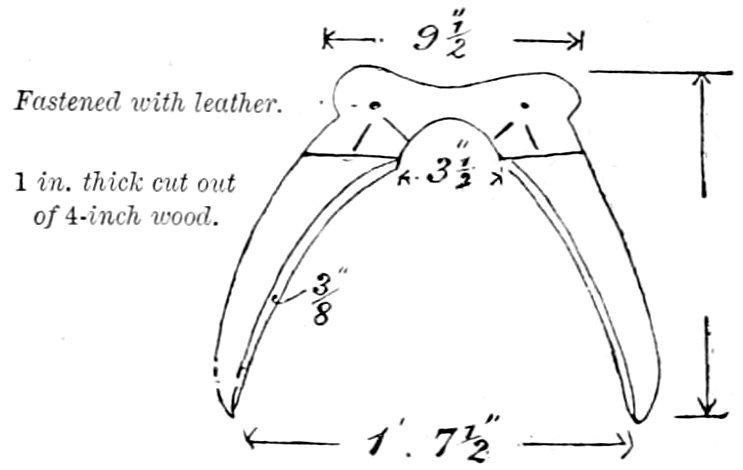
C������ P���-������ F���� ����.
C������ P���-������ S��� ����.
The animals are sagaciou s and well trained, and come when called. At the time of loading, a saddlecloth is placed on the mule’s back, the saddle with the packs attached is lifted by two men, the animal passes underneath,
and the saddle is placed on its back and kept in place by a crupper, and harness embracing the chest and rump. No belly-band is used, and the whole is quickly adjusted. Many small brass bells are placed on the trappings, and the leaders sometimes have a bell shaped out of resonant wood, fitted with a clapper, and hung over their heads. The tinkling of the small bells and the clatter of the large ones enable the men to trace their beasts if they stray during a halt, and give warning of their approach to elephant-drivers, so that they may back the elephants from the path, and thus save them from being scared. The only arms carried by this company of Chinese consisted of a couple of ancient horse-pistols and a large iron trident.
The traders from Yunnan generally proceed viâ Ssumao, Kiang Hung, Muang Long, and Muang Lim—places neighbouring the Meh Kong—to Kiang Hai, whence they find their way viâ Zimmé to Maulmain; viâ Penyow and Peh to Ootaradit, or Tha-It, in Siam; and spread by various routes over the Ping Shan States, to purchase raw cotton to carry back on their return journey. Some of the caravans returning from Maulmain sell their European goods at Kiang Tung, proceeding to it along the route traversed in 1837 by M‘Leod. A few of the caravans coming south likewise use this route, in order to dispose of some of the broad-brimmed straw hats they purchase in Yunnan. These hats are supplied with oilskin covers, and sell at Lakon, according to quality, at three rupees and six rupees each. They likewise bring from Yunnan opium, bee’s-wax, walnuts, brass pots, ox bells, silk piece-goods, silk jackets—some of which are lined with fur—silk trousers, figured cloth, and tea. From Kiang Tung they carry lead, dahs or swords, steel in ingots, lacquer-boxes, tea, and opium.
Noticing that the head-man wore a skull-cap of horsehair worked into a handsome lace, which he had bought for a rupee and a half, I purchased it from him for two rupees. On my showing him some black and white kinds of tailor’s thread, he tried their strength, and said that he had never seen any like them before, and when their virtues were known in Yunnan they would have a good sale, as they were much stronger than ordinary cotton-thread.
After breakfast one of the Christians from Ban Meh Kee, who happened to be in Kiang Hai, hearing of our arrival, came to see Dr M‘Gilvary. He said the land in the Kiang Hsen plain was exceedingly
fruitful, and that last season he received a return of fully 250 baskets of paddy for each basket sown.
Learning that the Chow Hona, or second chief, had returned, we went to call on him. On approaching his house we noticed four ladies winding silk in the verandah, one of whom at once went to call him. After welcoming us warmly, he said a wild elephant had just killed a man close to the city. The man’s companions, on seeing the elephant approach, had clambered up trees, and shouted to him to do likewise. He refused, saying the elephant would not hurt him. After the elephant had passed, they again called to the man, and receiving no answer, searched the jungle, and found his remains quite mashed up. The prince said this elephant was so fearless that it was in the habit of crossing the rice-fields close to the city in broad daylight. The Chow Hluang had issued an order against its destruction, as it was of enormous size, and served as a stallion for his female elephants. His feet, as measured from his footprints, were two feet broad; and therefore, as the height of an elephant equals double the circumference of his feet, his height would be 12 feet and 3 inches, or greater than that of any of the King of Siam’s elephants. There is a general belief amongst the Burmese and Shans that the spirits of human beings who have been slain by an elephant ride on the animal’s head, warning him of his approach to pitfalls and hunters, and guiding him to where he may kill people, so as to add to their own company. It is therefore considered hopeless to even fire at one which has destroyed many men. Tracking a wild elephant on foot is always dangerous, as it is liable to return on its path and attack its pursuers.
We had a long chat with the prince about the proposed railway. He appeared to be a very intelligent man, and although gaunt and ungainly in build, with an awkward gait, possessed great strength, and was evidently very active. His temperament was high-strung, and his black bead-like eyes wandered in every direction with a vigilance that nothing could escape. He seemed much interested in the extension of trade with Burmah, Siam, and China, and said the chiefs and people would be delighted if the railway was put in hand. Every help they could give would be gladly rendered; that teak was plentiful in the country, and free permission would certainly be granted to cut it for the sleepers and bridges. As for labour, as many
Kamooks as would be required could be hired from Luang Prabang. Their wages for working in the teak-forests were fifty rupees a year and food, and the latter did not cost more than three rupees a month. Gangs of Chinese Shans from the Shan States to the east of Bhamo come every year to work in the Ping Shan States, and could be employed on the railway. Other Shans would doubtless stream in from Yunnan when once it was known that more labour was required, and that good wages would be paid. A great part of the labour in Kiang Tung is carried out by Chinese from Yunnan.
The following day the Chow Hona breakfasted with us. In answer to our inquiries, he said the easiest route from Zimmé to Kiang Hsen was viâ Viang Pow and Muang Fang, crossing the Meh Khoke at Ta Taung, and thence over Loi Kee-o Sa Tai (2650 feet above the sea) to the Meh Chun, and along that river to Ban Meh Kee, where the route joins that which we had taken. A better route we afterwards found would be from Zimmé viâ Muang Ngai; thence up the Meh Pam, and over the Pe Pau Nam (water-parting) into the valley of the Meh Fang. The pass over the water-parting is only 2158 feet above the sea. From Muang Fang this route would follow that indicated by the prince, which was traversed by Mr Archer in 1887. The loop-line could be completed by joining Zimmé with the main line again at Lakon, or, viâ Muang Li, near the mouth of the Meh Wung.
On our returning his call, we found some of the fruit-trees in his garden absolutely laden with women and children picking the fruit, and teeming with laughter and merriment. Dr M‘Gilvary, being very much pleased with the paces of the female elephant I had been riding from Kiang Hsen, had arranged on the journey to purchase it from the mahout, who was its owner, for 500 rupees, and had just learnt that the Chow Hluang, whose serf the owner was, had decided to purchase it for 400 rupees, and that the man dare not say him nay. On his telling the Chow Hona of his disappointment, he said he would at once go and expostulate with the chief about it. It was only right that Dr M‘Gilvary should have the animal, as he had made the first and highest offer, and it was not fair that the man should be robbed of 100 rupees. He asked us to stop, and said he would be back in a few minutes. On his return he told us he had been successful; and that the Chow Hluang, who had not previously heard of Dr M‘Gilvary’s offer, had at once given up his claim. As a mark of his
friendship for the Doctor, the Chow Hona insisted upon presenting him with a handsome covered howdah for the elephant, and would not hear of payment being made for it. I noticed many similar instances of friendship on the part of the nobles I met on my journeys towards Dr M‘Gilvary, who seems by his utter unselfishness and frank cordiality, and great tact and kindness, to have won the esteem of the people of the country.
On the 30th March, being Sunday, he held a service in the town, and had a large audience of Shans. His delivery is very simple and unaffected. The man is a thorough gentleman at heart, as well as an earnest enthusiast in his mission. The more I saw of him, the more I liked him. I never, during our long journeys together, saw him do a selfish action. When tired, and nearly worn out with insomnia and fever, he sat up late, night after night, to translate for me, because otherwise I could not procure the information I required, as everything had to be packed and the elephants off by daybreak.
Many hundreds of Lapoon immigrants on their way to Kiang Hsen were encamped near our sala, and one morning fully 1000 others crossed the river on their way to Kiang Hsen. It is pitiful to learn from Mr Archer that he was told by the Chow Hluang of Kiang Hsen in 1887, that about a third of the immigrants had died since the foundation of the colony in 1881. In Mr Archer’s words, “The privations the early settlers had to suffer probably increased the mortality; but fever was doubtless engendered by clearing the rank vegetation, and will lose much of its virulence when the country is better occupied.”
One morning the mist lifted from the valley of the Meh Khoke, and I was able to sketch the hills stretching thirty miles to the west, or as far as the eye could reach. It was evident that the great rib spurs jutting towards the river from the northern range were very much higher than the backbone from which they sprang: this seems frequently to be the case in the hills between the Meh Kong and the Salween.
View
Whilst watching a couple of the elephant-drivers boxing with regular boxing-gloves, our old acquaintances the Moosurs came to pay us a visit, and again brought their children with them. It was merely a case of “How-do-you-do?” and “Good-bye,” as we had to go to the Chow-Hluang’s to complain about two of the promised elephants not having arrived. On reaching his house he told us that the wife of the owner of the elephants had sent word that the elephants had been scared by a jungle-fire, and had stampeded; that her husband was away after them, and had not yet returned. On our telling the Chow Hona the cause of the delay, he ordered the woman to be brought to the Court-house and put in chains. The elephants were at once brought in, and we were able to start on the morrow.
Next morning, the 31st March, the Chow Hona and Chow Nan Kyow Wong, our companion from Zimmé, came to see us off, and were accompanied by the Chow Phya, or head judge of Kiang Hai, who had been told off to conduct us to Penyow. Six large elephants, two of which had babies with them, had been hired for us, and Dr M‘Gilvary rode the elephant he had purchased. I once more chose an easy-going female elephant for myself, and had the amusement of watching the pranks of its big baby during the march. These young elephants were the source of immense fun, but were an intolerable
up the Meh Khoke from Kiang Hai.
nuisance to the men on foot, whom they delighted to playfully tumble over like ninepins when the opportunity, for which they were always on the alert, occurred. By half-past six we had said good-bye and left Kiang Hai, which is 183 miles distant from Zimmé by the road we were to take. The mileage on this journey implies the distance from that place, and therefore gets less as we proceed.
Leaving the city by the south gate, we journeyed for ten miles through the plain to the village of Yang Tone, situated on the Meh Low, where we halted for breakfast. Our march led us through or near eleven villages, all of which were embosomed in orchards fringed with beautiful feathery bamboos. On our way we met a caravan of thirty laden cattle, a company of eight Burmese Shans, and a Buddhist monk wearing a huge yellow turban, similar to those worn by the monks in the Chinese Shan States.
Ban Yang Tone is a large village stretching along the banks of the Meh Low, and contains a fine temple and monastery. On entering the latter, we found the monks and their acolytes making fireworks, amongst which were rockets to be used at an approaching festival. These rockets were formed of a tube of bamboo, 14 inches long and 2 inches in diameter, tied to a light bamboo 15 feet long, the head of
KIANG HAI TO LAKON
which had been turned into a whistle. Ten other whistles, of various lengths and notes, were fastened round the head of the rocket. When fired, the rocket ascends to a great height, and is accompanied by music made by the air rushing through the whistles. Other rockets of great size are made for setting fire to the funeral pyre on which the bodies of monks are burned. According to Mr Scott (Shwé Yoe), in his admirable work ‘The Burman,’ some of these rockets “are of huge size, constructed of the stems of trees hollowed out, and crammed full of combustibles, in which sulphur largely predominates. Many are 8 or 9 feet long and 4 or 5 in circumference, and secured by iron hoops and rattan lashings. Up in Mandalay some are very much larger. These are let off at the funeral pile from a distance of 40 or 50 yards, the largest being mounted on go-carts, and many others guided by a rope fastened to the pyathat, the rocket sliding along by means of twisted cane loops.”
On strolling to the Meh Low, I met two Lolo-Lawa women. One of these would have been taken for a handsome gipsy in England. An artist would have been gladdened by the chance of securing such perfection for his model. The grace of her pose, the faultless symmetry of her person, her fearless aspect, and perfect selfpossession, her pleasant voice, and the courteous unconstrained manner in which she answered my questions, bespoke her one of nature’s fairest works. Unluckily I had only the bumptious village elder Portow with me to catechise the woman; and a crowd of village boobies soon gathered round, who looked upon the whole matter as a joke, and jeered at the woman and her friend. She soon became justly and proudly irate, and refusing to impart further information, walked disdainfully away. The few words of her vocabulary that I procured, placed it beyond doubt that she was of the same race of Lawas whose villages I had passed in the upper portion of the valley of the Meh Low after leaving Muang Pa Pow. She said that she resided in one of the five Lawa villages that are situated in the basin of the lower portion of the Meh Low, which together contained about a hundred houses.
Leaving the village, we traversed a great rice-plain, and entered a forest of bamboo, in which many teak-trees were scattered. We soon afterwards crossed the Huay Wai, upon which is situated, three hours’ journey up-stream, the ancient city of Viang Wai (the rattan-
Rocket-stick of bamboo, formed into a whistle at the top.
cane city). Some of our men who made a detour through the city, reported that one of its gateways was still erect, and there were ruins of a temple inside the walls. The forest we now entered was brightened by yellow, orange, and red blossoms, and some of the trees were decked with tender spring foliage. After passing many teak-trees and another village, we crossed the Meh Low, here 300 feet wide and 12 feet deep, with 2 feet of water, and halted for the night at the pretty village of Ban Long Ha. We had travelled 15 miles during the day, and had risen 120 feet since we left Kiang Hai.
The next morning we were off by half-past five, and after skirting an old cut-off bend of the Meh Low (the ow in Low is pronounced as in “cow” in English), crossed the saddles of three small hillocks which mark the waterparting between the Meh Low and Meh Ing. The aneroid marked a fall from our camp to the crest of the saddles; but as there must have been a rise, I have assumed it to be 10 feet. The valleys between the hillocks are inundated to the depth of 3 feet in the rainy season.
Continuing through the vast plain, which, as near as I could judge, averages between 25 and 30 miles in breadth, we halted for the night not far from Ban Poo-ken, the headquarters of the governor of the district, which is known as Muang Hpan or Muang Phan.
Referring to this small province in 1887, Mr Archer writes: “Muang Phan, a cluster of villages half-way between Chienghai[7] (Kiang Hai) and Phayao (Penyow), forms an agreeable contrast to the new settlements farther north. The plain, laid out in rice-fields
interspersed with fruit-gardens and villages, is bounded on the west by gently sloping mountains (an isolated hill); the scenery is picturesque, and the general appearance of cultivation and prosperity is most refreshing.
“The former capital of Muang Phan is said to be situated at the foot of the low range of hills which bound the plain on the east, and a new town is now being founded on its site.
“The history of this small province is interesting, as showing in what manner colonies are effected, and how confusing are the boundaries of the different States. The country was evidently deserted during the early part of this century; later, a part of it was occupied by people from Lakhon (Lakon), who, however, afterwards withdrew farther south. About fifty years ago a settlement was made by people from Lamphun (Lapoon), who have since gradually brought the country to its present prosperous condition. Muang Phan is therefore governed by the State of Lamphun, though not adjacent to it; but both Lakhon on the south and Chienghai on the north lay claim to at least a portion of the little province.
“Whilst at Muang Phan, I witnessed another phase in the formation of settlements in this country. The chief of Chiengsen (Kiang Hsen) having received permission to establish in his province a number of the inhabitants of Muang Phan, proceeded, in the language of the country, to drive the people into the new colony. However sound may be this policy of migration, it was impossible not to commiserate the unfortunate people who were thus driven from a comfortable home into a bare, uncultivated country, where it would cost them many years of struggle to recover only a portion of their former prosperity. Unable to dispose at so short a notice of their houses, their gardens, and fertile rice-fields, they were compelled to abandon everything that could not be easily transported. I met many of these families, some carrying their children, or perhaps the domestic fowl, in their arms; and some, such few household goods as they were able to remove.
“Muang Phan, as well as the district under Phayao (Penyow) directly to the south, is populous, and appears, indeed, to enjoy greater prosperity than most of the surrounding country. It is well irrigated, and the crops are generally good, while many of the other common necessaries of life are here abundant and cheap. Fish is
indeed very plentiful in the extensive lake, or rather marsh, that occupies the centre of the plain, and it forms an important article of export, giving rise to a considerable trade with all the neighbouring States.”
Our proposed railway passes through both Muang Phan (Muang Hpan) and Phayao (Penyow) on its way to Kiang Hsen.
Having erected our tent with the aid of a few bamboos borrowed from the villagers, we sent a messenger to inform the Pau Muang (father of the State), or governor, of our arrival. Soon afterwards he came in and welcomed us, and sat down with us to dinner. He was a powerfully built, grey-haired, massive-headed old gentleman, about 5 feet 10 inches high; and had it not been for his costume and language, might have been taken for a fine old Scotch Highlander.
On receiving notice of our intention to pass through his province, he had set to work collecting transport for us; but only three elephants had as yet been brought in from the district, which, with sixty porters, he hoped would be sufficient to carry us and our baggage. After thanking him for making these arrangements, we said perhaps it would be better that the elephants with us should continue as far as Penyow, in which case we should not require additional means of conveyance. To this our elephant-men were agreeable, and thus a burden was taken off the governor’s mind.
He told us many deserted cities existed in his neighbourhood. Viang Poo Ken lay about half a mile west of our camp; Viang How, on the Meh Hsan; another Viang How, on the Meh Ing; Viang Teung (the city of teak-trees), on the Meng Loi; Viang Hsen Kong; and Viang Lau (Viang Law), on the Meh Ing, three days’ journey above Kiang Khong. He then drew a map on the ground with pieces of bamboo and matches, and explained to us the features and lie of the country.
The next day a Christian, eighty years of age, came to visit Dr M‘Gilvary; and Dr Cushing rambled with me through the villages, and strolled under the shade of noble trees, through splendid parklike scenery, to Viang Poo Ken. This deserted city is about half a mile square, and is divided into three compartments. Its outer rampart was 10 feet high, and its ditches 50 feet wide and 10 feet deep. Another fortress, circular, and 400 feet in diameter, crested the top of the hill. No ruins were found in the city and fortress. Buildings
built of wood or bamboos, if vacated in a moist climate like that of the Shan States, rot away in a few years, and leave no trace behind them. Even brick and stone buildings, when deserted, are rapidly destroyed by pipal-trees, and crumbling down, are covered with turf in the course of centuries. Those navvies the ants are ever throwing earth over the masonry records of past generations. These workers are nowhere more numerous, and their work is nowhere more speedily accomplished, than in Indo-China.
We left Muang Hpan in the afternoon, and made a short journey of 4½ miles to the Huay Kok Moo (the stream of the hog pens), where we halted for the night—having crossed several small streams and canals all flowing eastward into the Meh Hang, or into the fisheries through which that stream passes on its way to the Meh Poong. Huay Kok Moo itself, however, flows into a large lake-like marsh which serves as a fishery, and forms one of the principal sources of the Meh Ing. A cutting from the latter fishery into the Meh Poong, which enters the Meh Ing, would shorten the course of the Meh Ing by 30 miles, and save the Penyow plain from inundation, thus enabling a vast tract of country to be cultivated.
The population being sparse in the State, and not even a tenth of the available land having been taken up for agriculture, the people have thrown dams across some of the streams to turn them and the low-lying country into fisheries, into which shoals of plasoi, or young fish, ascend from the Meh Kong. This river commences to rise in April with the melting of the snow, and is in high flood in July or August. When at its highest, it inundates large tracts of country which serve as breeding-grounds for the fish. As the waters subside, the young fish enter the streams, and appear in dense lines fringing the banks on their way up-stream. The dams are partially removed at the close of the fishing season, to allow fresh fish to enter when they come up-stream to breed. Incalculable harm is being done to the drainage of the country by the fisheries, as the upper courses of the dammed streams will in time silt up, when great expense will be required to relieve the water-logged country. Streams should not be bunded until the end of the rains, and all dams should be removed before they commence.
The haze of the atmosphere, aided by the fires occurring amongst the long grass of the plains, had obscured our view since leaving
Kiang Hai; and the plain, except where broken by occasional hillocks, seemed interminable on all sides. The soil was rich, and it was evident that only more inhabitants were required to turn the plain into a vast rice-field.
Leaving camp soon after dawn, we continued for three miles through the grassy plain, crossing the beds of several dry streams and canals, and then entered the extensive rice-fields of Ban Meh Chai, the northern border village of Penyow, which contains 100 houses and a well-kept temple and monastery. According to the head-man of the village, owing to the land having been under cultivation for years, paddy only yields eighty-fold the amount sown in his fields, or less than one-third its yield in the newly taken-up land in the Kiang Hsen plain. Eighty-fold, however, is fully double the average yield in Burmah.
After crossing the Meh Chai, in the centre of the village, we skirted the fields for another mile, and crossed the Nong Hang near the site of a witch’s house, which had lately been pulled down, after the occupants had been driven from the village. Two miles farther, we came to and crossed the Meh Ing flowing to the right, close to the village of Ban Mai. This river was here 25 feet wide and 9 feet deep, and had only 1½ foot of water in its bed. It had a barely perceptible current, and flows south as far as Penyow, then doubles round Loi Loo-en and turns north-east on its way to join the Meh Kong. Turning to the east, we followed the plain for two miles to the foot of Loi Loo-en, along which the track continues to Penyow. Loi Loo-en is a pleasantly wooded hill about nine miles long, running nearly north and south, and has formed the site of several cities, some of which I subsequently visited during my stay at Penyow.
A fire was raging in the plain, and a terrified hare, the first I had seen during the journey, raced across the path in front of my elephant. The atmosphere had grown oppressive, and although scarcely eleven o’clock, the thermometer marked 91° in the shade. All were parched with thirst; the boys lagged one foot behind the other, and the men scratched holes in the dry stream-beds, seeking in vain for water. About one o’clock we reached a dry brook having a few muddy puddles in the bed, and determined to halt for breakfast. Half a mile farther would have taken us to the village of Pang Ngao, where
we might have got better water, but we were all-unconscious of its existence.
Getting off our elephants, we flung ourselves down under the shade of a great tree, where the temperature was 96°, and waited whilst the men dug holes in the ground in search of pure water. None was to be found, so at length the boys set to work to boil some liquid mud to make our tea. Such tea, when made, we had not the stomach to drink, and could therefore only rinse our mouths.
The march had been very distressing both to the elephants and men, and it was well that Penyow, where we were to rest, was only three miles distant. We started again, continuing to skirt the hill, and about three-quarters of a mile from Penyow passed the site of the ancient city of Chaum Taung, which is divided into three compartments by the usual ramparts and ditches. A little farther we came to one of the most sacred places of pilgrimage in the Shan States, Wat Phra Chow Toon Hluang (the temple of the great sitting Buddha), and scrambled down from our elephants to inspect it.
The walls were of plastered brickwork, and the beautiful roof rose in five graceful tiers to a great height. On entering the temple, we saw a colossal image of Gaudama 60 feet high, measuring 26¼ feet across the hips, with hands 6½ feet long. Great pieces of yellow cloth, interwoven with tinsel, covered the chest, and many tawdry banners were suspended over and around the image, which is said to be of pure gold, but doubtless has been formed of brick, and overlaid with the usual plaster and gold-leaf.
